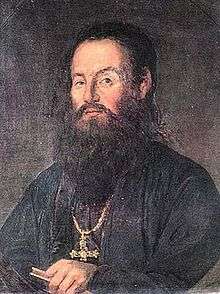Milies
| Milies Μηλιές | |
|---|---|
|
| |
 Milies | |
|
Location within the regional unit  | |
| Coordinates: 39°19.7′N 23°09′E / 39.3283°N 23.150°ECoordinates: 39°19.7′N 23°09′E / 39.3283°N 23.150°E | |
| Country | Greece |
| Administrative region | Thessaly |
| Regional unit | Magnesia |
| Municipality | South Pelion |
| Lowest elevation | 100 m (300 ft) |
| Population (2001)[1] | |
| • Municipal unit | 3,100 |
| Community | |
| Time zone | EET (UTC+2) |
| • Summer (DST) | EEST (UTC+3) |
| Postal code | 370 06 |
| Area code(s) | 24230 |
| Vehicle registration | ΒΟ |
Milies (Greek: Μηλιές) is a village and a former municipality in Magnesia, Thessaly, Greece. Since the 2011 local government reform it is part of the municipality South Pelion, of which it is a municipal unit.[2] It is a traditional Greek mountain village, at a height of 400 m on Mount Pelion. It is 28 km from Volos, the capital city of Magnesia. Milies is connected with the GR-34A (Volos - Promyri) It has traditional stone houses, cobbled roads, good restaurants and accommodation in abundance. Milies is also notable for being the terminus of the narrow gauge (60 cm) Pelion Railway, built between 1895 and 1903 by the Italian engineer, Evaristo de Chirico, father of the famous artist Giorgio de Chirico. This proved to be of considerable economic advantage to the region. The recently railway runs between Ano Lechonia and Milies twice a week at the weekend.[3] The village commands striking views across the Pagasetic Gulf and benefits from the many streams and water sources for which Mt. Pelion is renowned. These result in rich vegetation and cool, forested mountain slopes.
Subdivisions
The municipal unit Milies is subdivided into the following communities (constituent villages in brackets):
_%22VOLOS%22_in_Milies_station%2C_1990.jpg)
- Agios Georgios Nileias (Agios Georgios Nileias, Agia Triada, Ano Gatzea, Dyo Revmata, Kato Gatzea)
- Kala Nera
- Milies (Milies, Koropi, Stavrodromi)
- Pinakates (Pinakates, Agios Athanasios)
- Vyzitsa (Vyzitsa, Argyreika)
Nearest places
- Koropi
- Kala Nera, southwest
- Ano Lechonia, northwest
- Stavrodromoi
Population
| Year | Municipality population | Village population | Municipal district population |
|---|---|---|---|
| 1981 | - | - | 1,102 |
| 1991 | 3,737 | - | 952 |
| 2001 | 3,513 | 636 | 1,056 |
Geography
The Pelion mountains dominate the area, the valley covers the central part. Farmlands are adjacent to the village, which produces fruits, olives and vegetables.
History
The town was founded by people fleeing pirate attacks on Milies on the island of Euboea. The town was constructed inland and while the sea can be seen from the village, the community cannot be seen from the sea.
Anthimos Gazis and Grigorios Konstantas opened the school "Psychis Akos" in 1814 which is now a library with books and historic features. Milies was the first community of Pelion which saw the Greek War of Independence of 1821. Magnesia lost the battle and did not join the Greek Kingdom until 1881.
When Milies and the area became part of Greece in 1881, the Ottomans left the area.
Landmarks
The towns features a church known as Agios Taxiarchos which was built in 1741.
Notable people
- Anthimos Gazis (1758–1828), scholar of the Greek Enlightenment
- Grigorios Konstantas (1753–1844)
- Daniel Philippidis (ca. 1750-1832)
Sister cities
See also
References
- ↑ De Facto Population of Greece Population and Housing Census of March 18th, 2001 (PDF 39 MB). National Statistical Service of Greece. 2003.
- ↑ Kallikratis law Greece Ministry of Interior (Greek)
- ↑ "The Pelion Train - TrainOSE". TrainOSE. Retrieved 2015-06-03.
External links
![]() Media related to Milies at Wikimedia Commons
Media related to Milies at Wikimedia Commons
| ||||||||||||||||||||||
